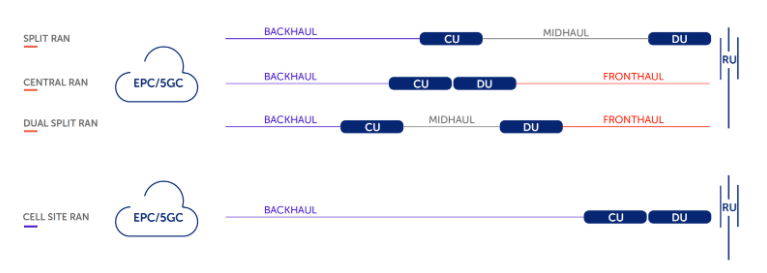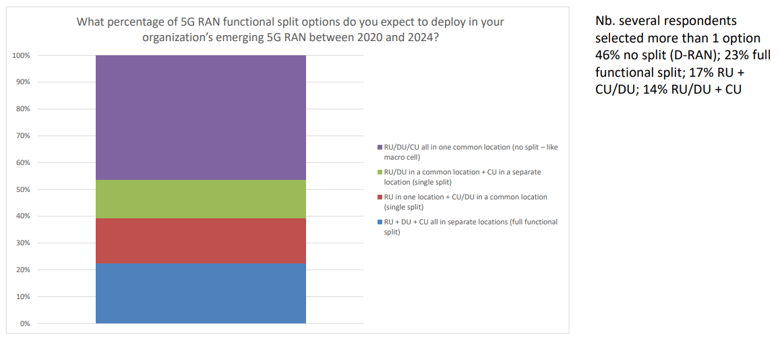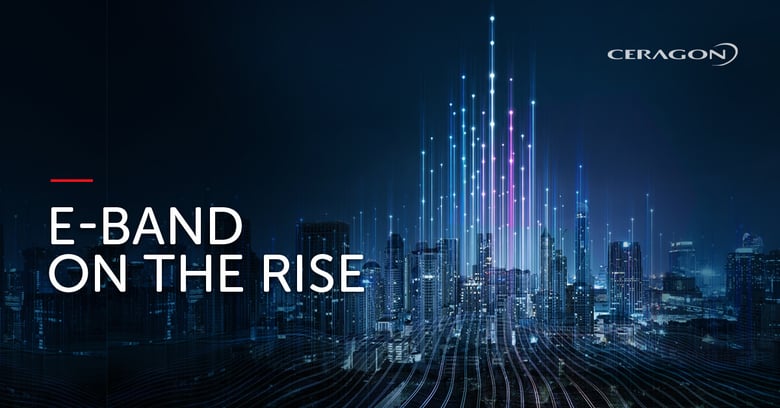|
|
The main catalyst for E-band mmW growth is that operators are adopting E-band to drive up capabilities to provide 5G capacity. Behind this need for ultra-high capacity are two key drivers. The first driver is high-traffic use cases such as massive video streaming, immersive virtual environments, mega-scale IoT services for industrial firms, security, public safety services and more.
The second key driver is the move to open network architecture, and specifically Open RAN. We’ve discussed previously how operators are disaggregating their networks. When it comes to horizontal aggregation, operators are splitting up the central unit (CU), distributed unit (DU) and radio unit (RU) and then locating them separately or together in various combinations.
5G fronthaul & midhaul configurations

Simply put, fronthaul connectivity comes into play when the RU is located separately from the DU. Midhaul connectivity describes the communication link between physically separated DUs and CUs.
In both of these scenarios, ultra-high capacities of 10 Gbps and above are required. In fact, we are already designing networks where the minimum capacity required starts at 20 Gbps, and even those requiring 50 Gbps and more.
Fronthaul is becoming increasingly essential with the growth of 5G networks. To understand how much, we conducted a survey in 2020 with Omdia, a leading global research firm. One key finding from that survey is that in 2024 about 40% of 5G sites will use fronthaul for connectivity.
40% of 5G sites will need a fronthaul connection by 2024
 (source: “5G Transport and Wireless Fronthaul Market Report,” Omdia, September 2020)
(source: “5G Transport and Wireless Fronthaul Market Report,” Omdia, September 2020)
The combination of fiber and wireless for transport purposes has proven to be fundamental to the success of 4G rollouts and will become imperative as 5G densification takes place. Successfully deploying a 5G network relies on the smart combination of fiber and wireless technologies to meet coverage and capacity requirements.
The Omdia survey asked operators what percentage of their 5G sites are new today, and what percentage of them will be new in 2024. Not surprisingly, more than 90% of new 5G base stations are located today in existing 4G sites. So these are not new sites, yet many of those which are connected via wireless backhaul will require capacity upgrades and modernizations. There are multiple ways to address those sites and we will cover those in one of our next blogs.
Looking forward, by 2024 about 40% of 5G sites, both existing and new, will undergo an architectural change in which the RAN elements will be split between different sites. This will be done to achieve key RAN efficiencies in resources management, namely frequency channels, mobility, latency management and other resources related to network slicing. These architectural changes are also raising the demand for 10+ Gbps hauling between network sites.
And this brings us back to that key result – 40% of operators’ 5G sites by 2024 will have the RU located separately from the DU. This basically means that 40% of 5G architecture will need fronthaul. And 5G fronthaul needs a lot of capacity – 10, 20, and soon 25 and even 50 Gbps.
Fronthaul isn’t the only viable 5G use case for E-band mmW. In Open RAN architecture, midhaul describes connectivity between the DU and the CU when they are not co-located (as stated above). Here, though less than for fronthaul, capacities of 10 Gbps and beyond are required. And in midhaul, like fronthaul, E-band mmW can serve as a cost-effective, rapidly deployed, and easy-to-scale complement to fiber.
In addition to 5G fronthaul and midhaul, E-band also can be a good match for other mobile and enterprise use cases. Stay tuned for more about other E-band mmW use cases and Ceragon’s flexible E-band offering.


